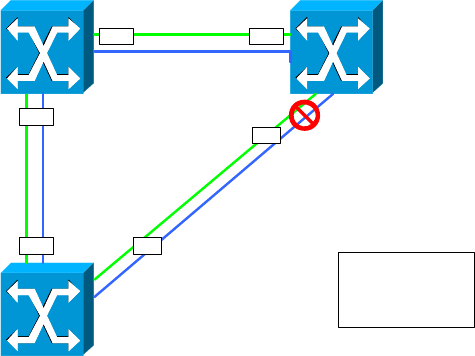
White Paper Issue: October 2006 Integration of BX600 SB9 Switches in Cisco Networks Page 12 / 47
therefore important that one native VLAN is defined at both VLAN trunks. Cisco recommends that this native VLAN should be
the same for both trunks to the SB9.
If the Po1 link or switch A itself fails, the SB9 will change the role of Po2 to “designated” and its state to “forwarding”, after going
through the state “learning”. According to the standard this will lead to a failover time of approximately twice the forward delay,
which in normal cases will be about 30 seconds. Depending of the size of the network this time can be reduced by tuning the
STP timers, but this must be done very carefully in order to provide a stable network. Please refer the standard 802.1D or
Cisco’s recommendations for timer tuning.
When the SB9 is running 802.1D it supports features such as Cisco’s proprietary port-fast when the “spanning-tree edgeport”
command is applied. This means that an access port will take on the state “forwarding” and will omit the states “listening” and
“learning”. This is needed when PXE boot mechanisms are used.
Running PVST+ on VLAN Trunks while disabling STP at the SB9
When STP is disabled at the SB9 it bridges the BDPUs without any modifications. Figure 4 shows this scenario.
SB9
STP disabled
Cisco A
priority 0 for all vlans
Po1
Po1
Po2
Po2
Po3 Po3
On all trunks:
VLAN 1 native
VLAN 10 tagged
VLAN 20 tagged
Cisco B
priority 4096 for all vlans
Alternate
discarding
Root port
forwarding
Designated port
forwarding
Designated port
forwarding
Figure 4 : PVST+ while STP is disabled at SB9
Since switch B receives the BPDUs of switch A, its port Po2 will get the role “alternate” and it will take on the state “discarding”.
The SB9 will not be involved in any decisions while the topology is changing.
If the link Po1 fails, switch B will not receive any BPDUs at Po2. After three times the “hello” interval, Po2 will initiate its change
to the role “designated” and will subsequently take on the “forwarding” state. Since no STP is enabled at the SB9, all the
switch’s ports will be enabled and forwarding as soon as they come up.
Without STP timer tuning, worst-case failover times resulting from link or switch failures were found to be approximately 45
seconds.


















